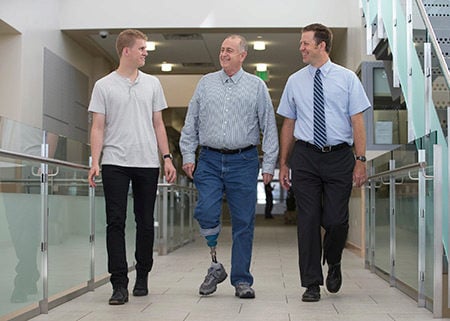Using Tech to Decipher Your Gait
With the help of a Fulton grant, Spencer Petersen is using a combination of resources that measures the forces under the foot to research the role your big toe plays in the simple act of walking.
October 2016

MRSA is bad news. If you’ve never heard of it, here’s what you need to know: It’s pronounced MER-suh, it’s a nasty bacterial infection and it can cause serious disease and death.
Senior molecular biology major Jacob Hatch knows MRSA as the infection that took his dad’s leg.
Hatch was thousands of miles away on an LDS mission when MRSA decalcified the bones in his dad’s foot and lower leg.
Now Hatch is exacting revenge on the bacteria. Researching alongside assistant professor of microbiology and molecular biology (and brother-in-law) Bradford Berges, Hatch is unlocking the power of a new MRSA-killer: bacteriophage.
Phages are viruses that seek out, infect and kill bacteria. Berges and Hatch’s research is showing that phages kill more than 99 percent of MRSA pathogens.
Thanks to the mentoring of Berges, Hatch has now published as an undergraduate student and is in prime position for medical school next year. He hopes his work can prevent others from the challenges his dad has faced.
“This research is my way of coping with it and feeling like I’ve been able to do something to solve these type of problems,” Hatch said. “It’s been so rewarding to see that it is working.”
Give to BYU
With the help of a Fulton grant, Spencer Petersen is using a combination of resources that measures the forces under the foot to research the role your big toe plays in the simple act of walking.

Reefs worldwide are constantly threatened. The Molokai-based conservation nonprofit ‘Āina Momona called on BYU for help.

For Isaac Rex, the reality of playing football for BYU was better than anything he’d ever imagined.